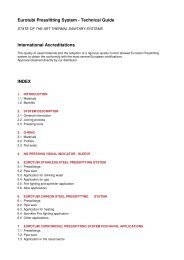corrosion of stainless steel - Damstahl
corrosion of stainless steel - Damstahl
corrosion of stainless steel - Damstahl
You also want an ePaper? Increase the reach of your titles
YUMPU automatically turns print PDFs into web optimized ePapers that Google loves.
Chapter 6 - Corrosion <strong>of</strong> Stainless Steel<br />
Of non-metallic impurities, (S) in particularly is problematic. As described<br />
in Chapter 4, S, in conjunction with manganese (Mn) forms manganese<br />
sulphides, which makes the <strong>steel</strong> short-chipped but also lowers the <strong>corrosion</strong><br />
resistance drastically. Manganese sulphides work as a point <strong>of</strong> attack for<br />
almost all types <strong>of</strong> <strong>corrosion</strong>, and as Mn is a necessary element to improve<br />
the hot rolling properties <strong>of</strong> the <strong>steel</strong>, it means that the higher the content<br />
<strong>of</strong> S in the <strong>steel</strong>, the poorer the resistance to <strong>corrosion</strong>.<br />
Stainless<br />
currency<br />
exchange rates<br />
6.2.6 Pitting Resistance Equivalent, PREN<br />
As Cr, Mo and N all affect the <strong>corrosion</strong> resistance <strong>of</strong> the <strong>steel</strong> positively, the<br />
question may well be asked: How good are the different elements? Is 1% Mo<br />
the same as 1% Cr - and what about N?<br />
Comparing Cr, Mo and N is a bit like having your pocket full <strong>of</strong> money in<br />
different currencies. That DKK 100 is more than DKK 75, which is more<br />
than DKK 50, is simple enough, but how much is DKK 100 compared to DKK<br />
40 + USD 5 + GBP 8? For this sort <strong>of</strong> thing you need the exchanges rates<br />
between the various currencies after which you will be able to convert to a<br />
common monetary unit (e.g. DKK).<br />
Similarly, ”<strong>stainless</strong> <strong>steel</strong> currency exchange rates” can be used. If Cr is used<br />
as the common monetary unit, dozens <strong>of</strong> laboratory experiments have<br />
shown that 1% Mo protects just as much as 3.3% Cr, and 1% N is just as<br />
good as 16% Cr. Thereby, we can develop a kind <strong>of</strong> 'currency gauge' named<br />
'Pitting Resistance Equivalent' (PRE or PREN). The designation ”PRE” is<br />
<strong>of</strong>ten used if only Cr and Mo are used in the calculation while ”PREN” is<br />
used if nitrogen, N, is included.<br />
Eq. 6.1:<br />
PREN = % Cr + 3.3 · % Mo + 16 · % N<br />
Two types <strong>of</strong> <strong>stainless</strong> <strong>steel</strong> with the same PREN will have approximately the<br />
same resistance against the initiation <strong>of</strong> pitting <strong>corrosion</strong>. The higher the<br />
PREN, the better, and it is worth noting that theoretically it does not matter<br />
whether 1% Mo or 3.3% Cr is added. It is the increase in PREN that is decisive.<br />
With Eq. 6.1 as the starting point it is possible to analyse the alloy composition<br />
<strong>of</strong> the <strong>steel</strong> and on the basis <strong>of</strong> the content <strong>of</strong> Cr, Mo and N evaluate how<br />
great is the resistance towards pitting <strong>corrosion</strong>. By looking at the alloy<br />
composition in the various types <strong>of</strong> <strong>steel</strong>, a chart can be drawn up – a kind<br />
<strong>of</strong> scorecard showing the different <strong>steel</strong> type's resistance towards pitting<br />
<strong>corrosion</strong>. Such a list <strong>of</strong> various commercial <strong>steel</strong> qualities along with their<br />
content <strong>of</strong> Cr, Mo and N is attached in Table 6.1. Note that all data are based<br />
on the <strong>steel</strong>s' minimum values for the various, useful alloying elements. Steel<br />
<strong>of</strong> the type 4307 may contain from 17.5% to 19.5% Cr, but it would be too<br />
optimistic to rely on the 19.5%. The only thing that is guaranteed is at least<br />
17.5% Cr.<br />
93<br />
RS for alle.indb 93<br />
9/29/2011 12:44:38 PM

















